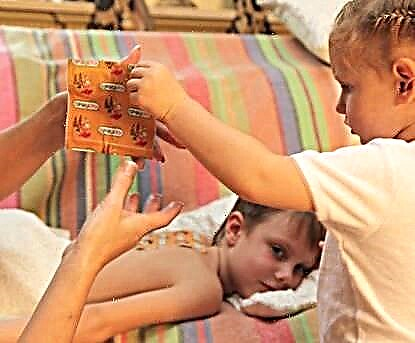
During the development of the baby in the womb, sometimes the processes of growth and formation of tissues and organs are disrupted, which leads to the appearance of defects. One of the most dangerous are heart defects.

What is heart disease?
This is the name of the pathology in the structure of the heart and large vessels that depart from it. Heart defects interfere with normal blood circulation, are detected in one out of 100 newborns and, according to statistics, are in second place for congenital pathologies.
Forms
First of all, they distinguish between congenital defect with which the child is born, as well as acquired, arising from autoimmune processes, infections and other diseases. In childhood, congenital defects are more common, which are divided into:
- Pathologies in which blood is dumped to the right side. Such defects are called "white" because of the pallor of the child. With them, arterial blood enters the venous, often causing an increase in blood flow to the lungs and a decrease in blood volume in the large circle. The defects of this group are defects in the septa that separate the heart chambers (atria or ventricles), the ductus arteriosus functioning after birth, coarctation of the aorta or narrowing of its bed, as well as pulmonary stenosis. In the latter pathology, blood flow to the vessels of the lungs, on the contrary, decreases.
- Pathologies in which the discharge of blood occurs to the left. These defects are called "blue" because cyanosis is one of their symptoms. They are characterized by the ingress of venous blood into the arterial, which reduces the oxygen saturation of the blood in a large circle. A small circle with such defects can both be depleted (with a triad or with Fallot's tetrad, as well as with Ebstein's anomaly), and enriched (with an incorrect location of the pulmonary arteries or aorta, as well as with the Eisenheimer's complex).
- Pathologies in which there are obstacles to blood flow. These include anomalies of the aortic, tricuspid or mitral valve, in which the number of their valves changes, their insufficiency is formed, or valve stenosis occurs. Also, this group of defects includes incorrect placement of the aortic arch. With such pathologies, there is no arterial-venous discharge.

Symptoms and signs
In most babies, heart defects that have formed in utero appear clinically even while the baby is in the hospital. Among the most common symptoms are:
- Increased heart rate.
- Blue discoloration of the limbs and face in the area above the upper lip (called the nasolabial triangle).
- Pale palms, tip of nose and feet, which will also feel cool to the touch.
- Bradycardia.
- Frequent regurgitation.
- Shortness of breath.
- Weak breastfeeding.
- Insufficient weight gain.
- Fainting.
- Swelling.
- Sweating.

Why are babies born with heart defects?
Doctors have not yet identified the exact causes of these pathologies, but it is known that violations of the development of the heart and blood vessels are provoked by such factors:
- Genetic addiction.
- Chromosomal diseases.
- Chronic diseases in the expectant mother, for example, thyroid disease or diabetes mellitus.
- The age of the expectant mother is over 35 years old.
- Taking medications during pregnancy that have a negative effect on the fetus.
- Unfavorable ecological situation.
- Staying pregnant in conditions of an increased radioactive background.
- First trimester smoking.
- Use of drugs or alcohol in the first 12 weeks after conception.
- Poor obstetric history, such as a past miscarriage or abortion, or a previous premature birth.
- Viral diseases in the first months of pregnancy, especially rubella, herpes infection and flu.
The most dangerous period for the formation of heart defects is the period from the third to the eighth week of pregnancy. It is during this period that the chambers of the heart, its partitions, and also the main vessels are laid in the fetus.
The following video explains in more detail the causes that can lead to congenital heart defects.
Phases
In every child, the development of heart disease goes through the following three phases:
- The stage of adaptation, when the child's body mobilizes all reserves to compensate for the problem. If there are not enough of them, the child dies.
- The stage of compensation, during which the child's body is relatively stable.
- The stage of decompensation, in which the reserves are depleted, and the crumbs develop heart failure.
Diagnostics
You can suspect the development of a congenital heart defect in a child during routine ultrasound examinations during pregnancy. Some pathologies become noticeable to the ultrasound doctor from the 14th week of gestation. If obstetricians know about the defect, they develop special tactics for managing childbirth and decide with cardiac surgeons the issue of an operation on the child's heart in advance.
In some cases, ultrasound during pregnancy does not show heart disease, especially if it is associated with a small circle of blood circulation that does not function in the fetus. Then you can identify the pathology in the newborn after examining and listening to the baby's heart. The doctor will be alerted by the pallor or cyanosis of the skin of the toddler, a change in the heart rate and other symptoms.

After listening to the baby, the pediatrician will identify noises, split tones, or other alarming changes. This is the reason to send the baby to a cardiologist and prescribe to him:
- Echocardioscopy, thanks to which it is possible to visualize the defect and establish its severity.
- ECG to look for abnormal heart rhythms.
Some babies have x-rays, catheterization, or CT scans to clarify the diagnosis.
Treatment
In most cases, for heart defects in a newborn, he needs surgical treatment. The operation for children with heart defects is performed depending on the clinical manifestations and the severity of the pathology. Some babies are shown immediate surgical treatment immediately after the detection of a defect, others perform the intervention during the second phase, when the body has compensated for its strength and will more easily undergo the operation.
If decompensation occurs with a defect, surgical treatment is not indicated, since it will not be able to eliminate irreversible changes that have appeared in the internal organs of the child.

After clarifying the diagnosis, all children with congenital defects are divided into 4 groups:
- Toddlers who don't need urgent surgery. Their treatment is postponed for several months or even years, and if the dynamics are positive, surgical treatment may not be required at all.
- Infants who should be operated on in the first 6 months of life.
- Babies who need to be operated on in the first 14 days of life.
- Crumbs that are sent to the operating table immediately after childbirth.
The operation itself can be performed in two ways:
- Endovascular. The child is made small punctures and through large vessels they are selected to the heart, controlling the whole process by means of X-ray or ultrasound. In case of defects in the septa, the probe brings an occluder to them, closing the hole. If the ductus arteriosus is not closed, a special clip is installed on it. If the child has valve stenosis, balloon plastic is performed.
- Open. The ribcage is cut, and the child is connected to artificial circulation.
Before and after surgical treatment, children with a defect are prescribed medications of different groups, for example, cardiotonics, blockers and antiarrhythmics. For some defects, the child does not need surgery and drug therapy. For example, this situation is observed with a bicuspid aortic valve.

Effects
In most cases, if the time is lost and the operation is not performed on time, the child's risk of various complications increases. Children with defects are more likely to develop infections and anemia, and ischemic lesions may also occur. Due to the unstable work of the heart, the work of the central nervous system can be disrupted.
One of the most dangerous complications of congenital malformation and after heart surgery is considered endocarditis, which is caused by bacteria trapped in the heart. They affect not only the inner lining of the organ and its valves, but also the liver, spleen and kidneys. To prevent this situation, children are prescribed antibiotics, especially if surgery is planned (fracture treatment, tooth extraction, surgery for adenoids, etc.).

Children with congenital heart defects also have an increased risk of such complications of angina as rheumatism.
Forecast: how long do children with heart disease live?
If the operation is not timely resorted to, about 40% of babies with defects do not live up to 1 month, and by the year about 70% of children with such a pathology die. Such high mortality rates are associated both with the severity of defects and with their delayed or incorrect diagnosis.
The most common defects found in newborns are an incomplete arterial duct, an atrial septal defect, and a defect in the septum dividing the ventricles. To successfully eliminate such defects, it is required to perform the operation on time. In this case, the prognosis for children will be favorable.
You can learn more about congenital heart defects by watching the following videos.
.



